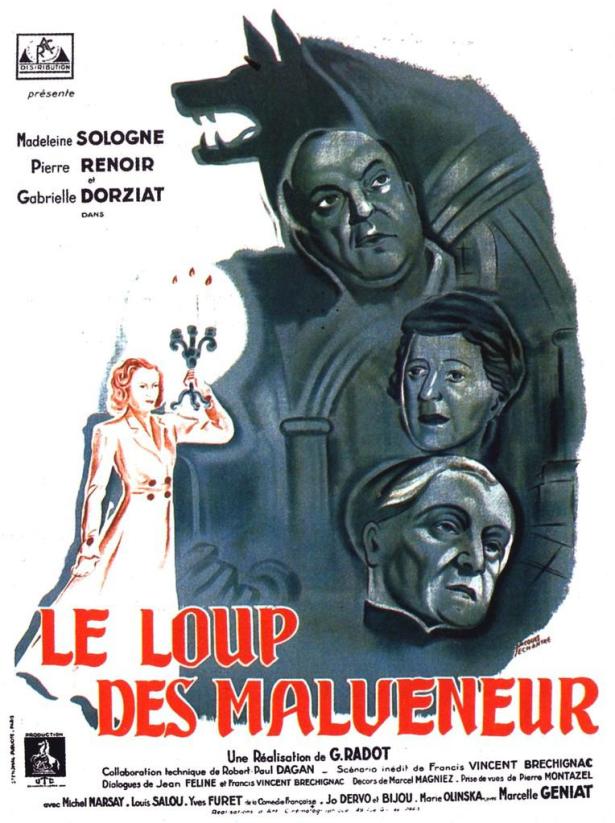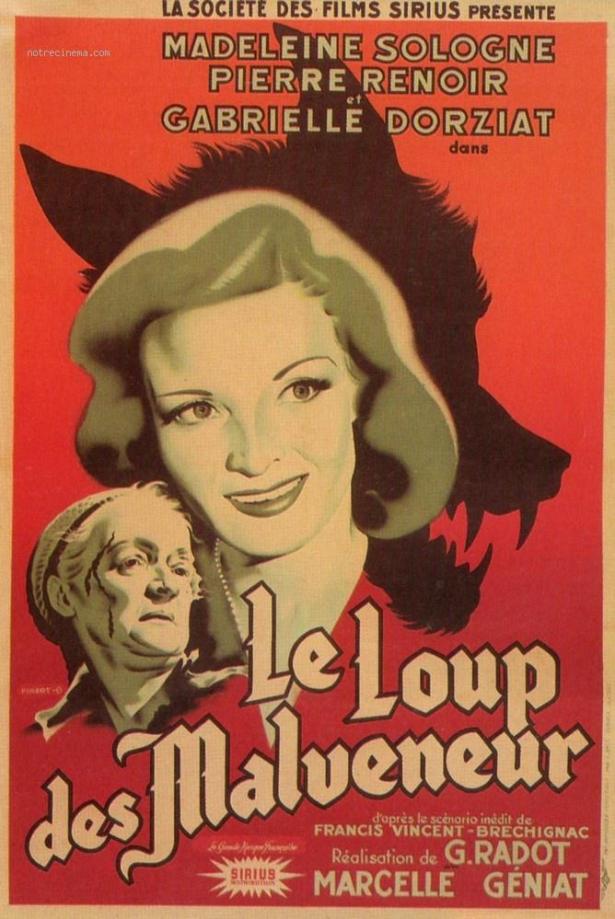This is an extra-credit installment of The Wolf’s Trail. I’d originally intended to charge straight ahead, keeping my focus limited to movies that saw wide release in the US (which makes my job a lot easier, since those movies are generally a lot more readily available to me that the films that never made it to America officially). Doing that would mean skipping some interesting and worthwhile movies, however, and up until the seventies there aren’t a whole lot of movies to cover even on an international scale. So, this week I decided to cross another film off my viewing list and expand my horizons by watching the 1943 French feature Le Loup des Malveneur!

This is the oldest surviving European werewolf movie, preceded by a couple of films based on a novel called The Wolf Man by Alfred Machard. That book is pretty obscure now as well, and I don’t know much about its contents yet, but it was made into a silent French film called Le Loup Garou in 1923, and adapted again as a German talkie in 1932, an obscure picture called Haunted People that reportedly abandoned the werewolf angle of the story. These movies are lost to history, like the American films The Werewolf and The White Wolf AKA The White Hunter (both of which focused on the idea of Native American skinwalkers, rather than drawing from European lore), which leaves us with this movie as the oldest surviving example of a European werewolf movie.
I frankly don’t have a whole lot to say about this film. This may come as a relief, given how long these entries have been getting. For one thing, I had no luck finding a translated edition of the movie available for digital viewing anywhere, though a couple of DVD sellers whose relationship with international copyright laws remains somewhat ambiguous were offering a subtitled version of the film for sale. So, rather than spend $20 and wait for this curiosity to be delivered to me, I settled in to watch the film on Youtube, where I found a version of the movie that looks like it was transferred from film stock recovered from the trunk of a car found at the bottom of the river. The picture was almost indecipherable at times, there were no English subtitles, and I don’t speak a lick of French, so I can’t shed much light on the nuances. I can tell you that this movie is a product of Nazi-occupied France; that the credits, music, and cinematography all show the direct influence of the Universal horror films; that the plot involves a cursed family of aristocrats named Malveneur (which translates to bad huntsman, or evil master of the hounds, if my rudimentary Latin knowledge and basic dictionary-using skills do not betray me) who are holed up in their spooky castle, with a young woman who’s evidently a governess of some sort to the adorable little Malveneur child who is soon to be orphaned by the events of the film. There’s also a young painter who seems to be the love interest for the heroine, and ultimately the guy in charge of saving the day. I gather he’s an undercover cop. There’s no actual lycanthropy on display, but there is a mad scientist with a lab in the bowels of the castle, and he ends the movie by setting his lab on fire and jamming on a harmonium as the flames consume him and his ancestral home.
If you want to learn more about this movie from someone who actually seems to know what they’re talking about, Films de France has a good write-up that looks at the movie as a subtly anti-Nazi work, and Kinoeye has a very interesting review of the film that focuses more on the family dynamics. My takeaway is that this is a movie about the decadence and corruption of old blood, and ultimately about the monstrousness that ensues when an amoral obsessive with a sociopathic sense of entitlement to everything around him gets fixated on the idea of protecting his bloodline’s dominance. Which, yeah, definitely sounds relevant to what was happening to France in 1943.
So, this is perhaps the first movie the really engage with the European folklore surrounding lycanthropy. I gather that the Malveneur curse starts when an ancestor was proved to be a monster, by dying of the wounds given to a marauding wolf. The peasantry certainly seems to believe the family’s cursed with the mark of the beast, and the mandatory pitchfork mob (again showing the influence Universal had) hunts and kills a wolf at the climax of the picture. The presence of actual lycanthropy in the movie is implicit at best, but what is fully on display is the power of the idea, and its effectiveness as a metaphor for the very real evils surrounding this family. A few years later Universal would touch on this idea in She-Wolf of London, and over at RKO this very same year Val Lewton produced The Leopard Man in a similar vein: people can become monsters without physically transforming into a hairy beast. These are werewolves who keep their hair on the inside of their skin.
In 1943, monsters like that were marching in the streets all over France.

In conclusion, here we have the earliest tentative experiment in showcasing authentic medieval European folklore in a modern horror movie, an example of how Universal’s monster movie aesthetic was adapted overseas, a look at what Vichy France’s cinema was doing, and a potent metaphor for fascism.
Kill Nazis.
